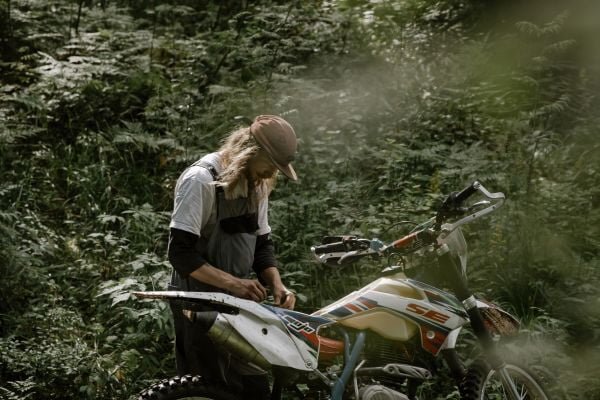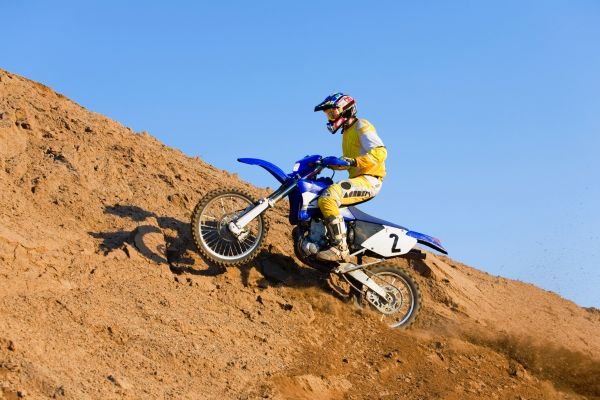Bump starting, sometimes referred to as push starting or roll starting, is an indispensable skill that comes in handy when your dirt bike’s electric starter or kick starter decides to give you a hard time, or when the battery runs out of juice. It’s a technique that proves invaluable for riders who venture into remote places where standard starting methods might not be an option.

To bump start a dirt bike, you’ll disengage the clutch, push the bike to build up some speed, and then release the clutch to turn the engine over. As valuable as this skill may be for any off-road enthusiast, it’s crucial to remember that bump starting carries its share of risks.
At Southseascycles, we always put safety first, and we want our fellow riders to be aware of the potential hazards associated with bump starting. Executing this maneuver requires care and precision to avoid mishaps, particularly on rough terrain or in congested spaces.
By recognizing the risks and following a detailed, step-by-step guide, dirt bike riders can tackle push starting with confidence and safety when the situation calls for it.
Quick Navigation
Preparations for bump starting
Before attempting to bump start your dirt bike, it’s essential to take certain precautions to ensure a safe and successful process. First and foremost, carefully choose a suitable location to perform the maneuver. Ideally, you should select a flat or slightly inclined surface, as a gentle slope can make it easier to build up the necessary momentum.
Furthermore, the area should be clear of obstacles, such as rocks, debris, or other hazards that may interfere with your ability to push the bike and ride it once the engine starts. Adequate space is also crucial, as you’ll need sufficient room to gain speed and safely bring the bike to a stop if necessary.
In addition to selecting an appropriate area, you’ll need to ensure your dirt bike is properly set up for bump starting. Begin by turning the ignition key to the “on” position and making sure the kill switch is set to “run.” If your bike has a fuel petcock, ensure it’s switched to the “on” or “reserve” position to allow fuel flow. Taking these preparatory steps will help maximize your chances of a successful push start, allowing you to safely get your dirt bike up and running.
How to bump start a dirt bike – Step-by-Step Guide
Here’s a step-by-step guide on how to bump start a dirt bike:
- Find a safe area: Look for a flat or slightly inclined surface that’s clear of obstacles and has enough space for you to push the bike and then ride it once it starts. A gentle slope can make bump starting easier.
- Turn on the ignition: Make sure the ignition key is turned to the “on” position and the kill switch is in the “run” position. If the bike has a fuel petcock, ensure it’s set to the “on” or “reserve” position.
- Get the bike in gear: Stand on the left side of the bike and hold the clutch lever in (disengaging the clutch). Shift the transmission into second gear, as it provides a smoother start than first gear.
- Start pushing: With the clutch lever still squeezed, start pushing the dirt bike to build up momentum. You can either push it yourself or have someone help you. Aim for a jogging pace, around 5-10 mph (8-16 km/h).
- Release the clutch: Once you’ve gained enough speed, quickly release the clutch lever while simultaneously giving the bike a little bit of throttle. This will engage the engine and, if done correctly, the engine should start running.
- Pull in the clutch again: To avoid stalling, when you start the engine, pull in the clutch lever right away and adjust the throttle accordingly. If the engine doesn’t start on the first try, repeat steps 4-6 a few times until it starts successfully.
- Shift into the desired gear: To start moving, shift into the gear that suits your riding conditions after starting the engine and slowly release the clutch.
It’s important to be careful when push-starting a dirt bike, especially in crowded areas or on uneven terrain. Make sure to wear proper safety gear and use caution during the process.
Tips and troubleshooting
Bump-starting a dirt bike is a skill that requires practice. It’s normal to face challenges while learning. Don’t lose hope if your first attempt is not successful. Be prepared to repeat the process a few times, ensuring you maintain proper technique each time.

Make sure you’re releasing the clutch lever quickly while simultaneously giving the bike a slight twist of the throttle. You may need to adjust the amount of throttle input to find the sweet spot for your specific dirt bike, as this can vary between different models and engine sizes.
While push starting can be a valuable skill for dirt bike riders, it’s important to recognize situations in which attempting this technique may not be appropriate or safe. If you’re dealing with a mechanical issue beyond a dead battery or failed starter, bump starting may not resolve the problem and could potentially exacerbate the issue.
Additionally, if the terrain is too steep, slippery, or crowded with people or obstacles, attempting to bump start your bike could pose a risk to both you and others. In such scenarios, it’s best to address the underlying issue or seek an alternative solution, always prioritizing the safety and well-being of your dirt bike.
Safety Considerations
Safety should always be a top priority when attempting to push start a dirt bike, as the process carries inherent risks if not executed properly. First and foremost, ensure that you’re wearing appropriate safety gear, including a helmet, gloves, goggles, and protective clothing, such as a riding jacket, pants, and boots. This protective equipment can help minimize the risk of injury in the event of a mishap during the bump-starting process.

Moreover, it’s crucial to avoid attempting a jump start on uneven terrain or in crowded areas. Uneven ground can make it difficult to build up the necessary speed and maintain control of the bike, while crowded spaces increase the risk of collisions with people or objects. Always opt for a flat or gently sloping surface that’s clear of obstacles and provides sufficient space for pushing and riding the bike once it starts.
Lastly, understanding the risks associated with bump starting can help you approach the task with the appropriate level of caution. Be aware that if not executed correctly, bump starting can result in accidents, bike damage, or even personal injury. By familiarizing yourself with the proper technique and practicing in safe environments, you can minimize these risks and become more adept at jump-starting your dirt bike when necessary.
Maintenance Tips to Prevent the Need for Bump Start Your Bike
To minimize the need to bump-start your dirt bike, it’s essential to keep up with regular maintenance and address potential issues before they become problematic. Begin by routinely inspecting and charging the battery, checking for corrosion and loose connections that could affect performance. If you have a conventional battery, maintain proper electrolyte levels by topping up with distilled water as needed.
A healthy starter system is also crucial for avoiding bump starts. Regularly inspect and clean the starter motor to ensure optimal operation, and check the starter solenoid and wiring for any signs of wear or damage.
Additionally, proper care for your dirt bike’s fuel system can help prevent starting issues. Keep the carburetor or fuel injectors clean and well-maintained, and replace fuel filters as needed to ensure a steady flow of fuel to the engine.
Routine inspection and adjustment of the clutch can also help prevent the need for bump starting. Check the clutch cable and lever for wear and proper tension, and examine the clutch plates and springs for signs of wear or damage, replacing them as necessary.
Finally, adhere to the manufacturer-recommended service intervals for your dirt bike. Regular oil changes, air filter maintenance, and valve clearance checks and adjustments are all crucial to maintaining your bike’s overall health and performance, reducing the likelihood of needing to resort to bump starting.
Conclusion
In conclusion, bump starting is a valuable skill that can help dirt bike riders overcome starting issues when traditional methods fail or the battery is depleted. The process involves selecting a suitable location, preparing the bike by setting the ignition and fuel flow, disengaging the clutch, pushing the bike to gain momentum, and then releasing the clutch to turn the engine over.
However, it’s crucial to emphasize the importance of safety and caution when attempting to jump start a dirt bike, as the technique carries inherent risks if not executed properly. Always wear appropriate safety gear, avoid bump starting on uneven terrain or in crowded areas, and understand the risks associated with the process.
By practicing and mastering the art of bump starting, riders can tackle challenging situations with confidence and safety. In addition to honing this skill, it’s essential to maintain a regular maintenance schedule for your dirt bike to minimize the need for bump starting in the first place. With the right combination of skill, preparation, and care, riders can ensure their dirt bike adventures continue uninterrupted and enjoy a better overall riding experience.
Frequently Asked Questions (FAQs)
Does bump starting a bike damage it?
When executed properly and in the right conditions, bump starting a dirt bike should not cause any damage to the bike. However, performing it incorrectly or in unsuitable conditions can potentially harm the engine, transmission, or other parts of the bike.
Can you bump start a dirt bike without a battery?
Yes, it is possible to bump start a dirt bike without a battery, especially if the bike has a carbureted engine and a magneto-based ignition system.
In such cases, the ignition system can generate the necessary spark without relying on the battery, and the bump start method can be used to turn over the engine.
What gear is best for bump start?
The best gear for bump starting a dirt bike is typically second gear. Using second gear provides a more manageable balance between momentum and engine resistance compared to first gear.
First gear might cause the rear wheel to lock up or skid due to higher engine resistance, while second gear allows for a smoother engagement and a higher likelihood of successfully starting the engine. In some cases, particularly for larger bikes or bikes with more powerful engines, third gear might also work well for bump starting. However, second gear is generally the most recommended option for the majority of dirt bikes.
- Unveiling the Honda Ruckus Top Speed and its Thrilling Performance - June 20, 2023
- Unveiling the Mystery: What is a Bobber Motorcycle? Unleash the Essence of Raw Power and Timeless Style! - May 26, 2023
- Maintenance Tips for Your Enduro Electric Bike: Essential Guide for Optimal Performance - May 23, 2023
